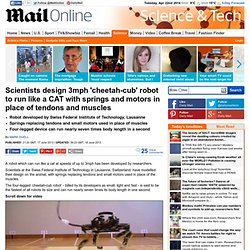

NASA's Rock Climbing Robot Could Tackle Everest With Ease. Unleash the Kraken! Robot octopus learning to swim. A prototype octopus robot uses its flexible tentacles to scull through the water Image Gallery (7 images) The octopus is a natural escape artist.

It can squeeze its soft body into impossibly tight spaces and often baffles aquarium workers with its ability to break out of tanks. These abilities could be very useful in an underwater robot, which is why the OCTOPUS Project, a consortium of European robotics labs, is attempting to reverse engineer it in all its tentacled glory. Now researchers from the Foundation for Research and Technology (FORTH), in Hellas, Greece are learning how the robot might use its tentacles to swim. View all Back in 2011 we got a glimpse of the project's first stab at an artificial tentacle, which could have far-reaching implications for soft-bodied robots of the future. Most of the time an octopus crawls to get around, but they swim quickly to avoid predation using a built-in water jet. Source: OCTOPUS Project via IEEE Spectrum About the Author.
Sandia Robot Rodeo showcases the latest in bomb defusing robots. The seventh annual Western National Robot Rodeo is set to get under way today in Albuquerque, New Mexico.

The five-day event is hosted by Sandia National Laboratories, and will feature civilian and military bomb squad teams from across the land. The goal of the 10-event technical challenge is to find the best robot designs for diffusing dangerous situations. The indoor and outdoor challenges change and evolve each year, but typically involve some sort of explosive or hazardous material removal. Sandia National Laboratories is closely linked with the US Energy department. Swiss scientists develop 'cheetah-cub' robot that can run like a cat at 3mph. Robot developed by Swiss Federal Institute of Technology, LausanneSprings replacing tendons and small motors used in place of musclesFour-legged device can run nearly seven times body length in a second By Mark Duell Published: 21:20 GMT, 17 June 2013 | Updated: 06:23 GMT, 18 June 2013 A robot which can run like a cat at speeds of up to 3mph has been developed by researchers.

Scientists at the Swiss Federal Institute of Technology in Lausanne, Switzerland, have modelled their design on the animal, with springs replacing tendons and small motors used in place of the muscles. Rollin' Justin Robot Catches Balls, Makes Coffee. The Rollin' Justin robot and his counterpart DESIRE have been busy impressing humans since 2009, but Rollin Justin's latest achievements outshine his trash-tossing past.

The German Aerospace Agency-designed robot can now catch objects thrown at him by using a mix of head-mounted cameras, tracking software and his precision-grasping. It's no easy task -- there's a lot that goes into catching a randomly thrown ball. You have to pay attention to the ball's direction and trajectory, rotate your shoulders to prepare for the catch, move your hand to where you think the ball will land, and then grasp at the right moment. And, with his vision, speed and bendable appendages, Rollin' Justin is able to catch not just one but two thrown balls. High-Speed Robot Hand. Video. Robot Skin Can Feel Touch, Sense Chemicals, and Soak Up Solar Power. When you meet your robot overlord, it may be wearing super-intelligent skin designed by a Stanford researcher--a solar-powered, super-sensitive, chemical-sampling covering that makes your meatbag covering look pathetic.

Zhenan Bao is behind the advances, and the recent development centers on a stretchable solar cell system that can expand and shrink along two different axes, making it perfect for incorporation into artificial skin for robots, human prosthetic limbs, or even clothing. Video: Japan's New Goateed Geminoid Robot Is Uncomfortably Realistic. Actroid F Female Telepresence Robot Looks Super Real, Creepy. Actroid F can speak in your place, using webcams to watch and mimic your facial expressions and movements.

When you speak with your family over a webcam they may be able to see your face, but they don’t have a real body in the room with which they can interact. Mini robot helicopters build towers, pyramids or walls. Sandrine Ceurstemont, video editor If you want to build a small tower or pyramid, flying robots can now do the heavy lifting for you.

Daniel Mellinger and his team from the GRASP Lab at the University of Pennsylvania have developed a system that allows flying robots to construct just about any structure (see video above). A human only needs to decide on the design before an algorithm takes over to determine where parts should be placed to create it. Tiny helicopters then follow these instructions and coordinate with each other by choosing the next part placement in a list.
The team also developed a gripper that can easily pick up parts lying horizontally or upright. Earlier this year, the researchers had these robots perform acrobatic feats, like doing triple flips in the air and flying through windows at various angles. Kinect Hack Makes Robot Mimic Its Master - PCWorld. Robots learn to walk like a senior citizen - tech - 22 December 2010. Video: Robot moves like a senior citizen Today's humanoid robots are able to run, somersault and even dance – now comes a robot that walks like a senior citizen.

It leans on objects in its environment for support to help it move around and complete tasks. Robots, and more importantly roboticists, are looking at objects in the wrong way, thinks Sébastien Lengagne of Japan's National Institute of Advanced Industrial Science and Technology in Tsukuba. Someday, This Robot Will Run Faster Than Us All. Aggressive Maneuvers for Autonomous Quadrotor Flight. Magnetically-guided pill sends pictures from inside the stomach. Siemens Healthcare and Olympus Medical Systems Corporation are collaborating on the development of a technology for a magnetically guided capsule endoscope (MGCE) system (Image: Siemens) Image Gallery (5 images) Stomach examinations may soon become more comfortable and less invasive with the development of a magnetically guided capsule endoscope.

Jointly developed by Olympus and Siemens, the capsule is swallowed by the patient and wirelessly transmits high-res, real-time images from inside the stomach while the doctor navigates using a joystick. View all Once the patient has swallowed the capsule they are positioned so that their stomach, including the capsule, is located in the center of an artificially generated magnetic field. The capsule endoscope has cameras at both ends and is controlled by means of varying magnetic fields. The capsule, which is at prototype stage, has received positive feedback during trials. This new method of endoscopy is also accurate.
A Robot That Balances on a Ball.